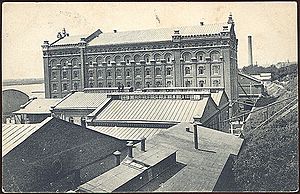Paramonov Mill facts for kids
The Paramonov Mill (Russian: Парамоновская мельница) was a very important grain mill in the city of Rostov-on-Don, Russia. Today, you can still see its ruins. They stand at the corner of Beregovaya Street and 7th of February Lane. A famous Russian businessman named Yelpidifor Paramonov once owned this mill.
History of the Mill
Rostov-on-Don is a big city in southern Russia. It was a major trading hub because it is located right on the Don River. This area was famous for growing lots of grain. Many merchants bought and sold rye and wheat. They also processed grain into flour.
Before the 1917 revolution, there were many barns, warehouses, and grain mills along the Don River. A merchant named Pyotr Fyodorovich Posokhov owned a very large and modern mill. It had the newest equipment for its time. Posokhov helped supply Rostov with flour. Because of his important work, a street was named after him in 1888. It was called Mill Descent.
In 1889, a new owner bought the mill and its land. This was the merchant Yelpidifor Paramonov. The mill worked for seven years under his care. But in 1896, a big fire destroyed it. After the fire, the price of bread went up a lot. This event is written about in a book called In Old Rostov.
Rebuilding the Mill
It took Paramonov two years to rebuild the mill. The new building had six floors. He also put in brand new equipment. The rebuilt mill became the biggest and most modern grain processing factory in the Russian Empire. It could process one hundred tons of grain every day!
The mill sent its products all over Russia. It also exported grain to other countries. These included Italy, Germany, Greece, Turkey, and countries in the Balkans. To make sure his grain reached customers easily, Paramonov even bought his own fleet of ships.
Ye.T. Paramonov became known as "the bread king of Russia." People called Rostov-on-Don "the granary of the Empire." The six-story mill on the Don River was at the center of this grain business. Paramonov also built large warehouses next to the mill on Beregovaya Street. This spot was perfect because ships could dock nearby on the Don River. These warehouses later became famous as the Paramonov Warehouses.
After the October Revolution, the government took over the mill. It was first called "Mill number One of Soyuz Khleb." Later, it became "state-run Mill number One." The mill kept working until February 7, 1930. On that day, another fire broke out.
The 1930 Fire
On the night of February 7, 1930, a large explosion happened. It was during the night shift. Flour dust in the factory exploded, and a huge fire started. It took several days for firefighters to put out the blaze. The fire was likely caused by a small spark or a burning cigarette. This caused the flour dust floating in the air to explode. In the same year, the street name Mill Descent was changed again. It became "7th February Street."
The mill building was never rebuilt after this fire. It remains in ruins today. There is a nearby building at №30 Nizhneboulvarnaya Street. This building is listed as an architectural landmark. It was built in 1879 and was once the "house for the staff of the mill owned by Posokhov."
Years later, an engine from the Paramonov Mill was found. It was in the village of Ryabichev, in Volgodonskoy District. This engine has been fixed up. It is now in good condition and can still work.



